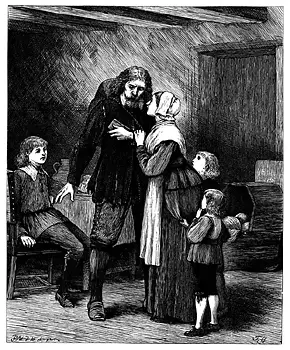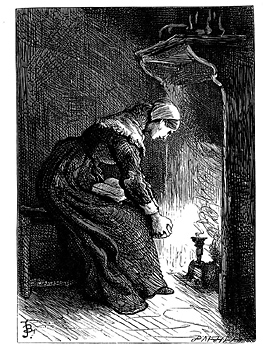Puritanism: Faith of Extremes
Puritanism arose in England in the early 1600s and quickly set itself apart from other Protestant faiths in its strict adherence to the doctrine of predestination, the idea that God has selected people to be saved before they are ever born and that no amount of acts that the non-saved do in their life, no matter how many and how good, can change their salvation status. (By extension, it could be argued, the saved couldn't do anything in their lives, no matter how bad, to convince God to renege on their promised salvation. This aspect wasn't normally influenced by Puritan preachers, however.)
The radical beliefs that set the Puritans apart from their Protestant brethren were these:
- Total Depravity: Man has not right to salvation because of the original sin of Adam
- Unconditional Election: No on can change their selection status for salvation. They are either chosen or they are not.
- Limited Atonement: Humans can do only so much to please God.
- Irresistible Grace: Humans benefit from God's grace, which cannot be denied or ignored.
- Perseverance: Once a person is saved, he is always saved.
 As more and more Puritans traveled to the American colonies, they began to set up a church infrastructure in their new homes, primarily in New England. Moreso than in England at this time, the Church was very much in control of people's lives, laying down laws based on faith and a strict interpretation of Biblical laws.
As more and more Puritans traveled to the American colonies, they began to set up a church infrastructure in their new homes, primarily in New England. Moreso than in England at this time, the Church was very much in control of people's lives, laying down laws based on faith and a strict interpretation of Biblical laws.
All of these things combined made the Puritans into a very black-and-white society, in which you were either saved or not, in God's grace or not, leading a good life or not, capable of good things or not, and obeying the law or not.
Well-known Puritan leaders in America were Increase and Cotton Mather, both powerful preachers and inspirational men whose voices and beliefs held their people in a powerful sway. One of these beliefs, which Puritans believed in very strongly, was that humans were in constant temptation by "the devil," who was actively striving to destroy God''s good work in the world. Puritans believed that people who couldn't or didn't resist the temptations of "the devil" made a pact with him to do his evil work and that these people were sinners and criminals. Women who made pacts with the devil were called witches. Men who made such pacts were called warlocks. It is hugely significant that far more witches were ever named than warlocks and that the vast majority of people persecuted, tried, and executed—in America and in Europe—were women. (Whole fields of study have evolved centering on this point, that women were far and away the primary victims of witch hunts. In some villages in Europe, nearly the entire female population was banished or killed. Many historians are convinced that witch hunts were a method of subjugating women or removing them from influence. In extreme cases, of course, they were eliminated entirely, not only from villages but from the Earth.)
 "Leading a good life" was a Puritan's primary duty. This included fulfilling one's duty to God and to one's family, whatever that happened to be. Children growing up were supposed to away their parents. When they reached a certain age, they were expected to work and get married (not always in that order). Whey they got married, they were expected to build a home and life for the family, which was supposed to include children. Parents were expected to remain monogamous, and any deviance from this practice was seen as a sign not only of physical weakness but also of evil deeds. By extreme definition, sexual deviance was proof of a compact with the devil. This practice was very much frowned on and rigidly enforced by the Church, the de facto lawmakers and -givers of New England society. Those caught in affairs were punished religiously and considered outcasts. One need look no further than Hawthorne's The Scarlet Letter.
"Leading a good life" was a Puritan's primary duty. This included fulfilling one's duty to God and to one's family, whatever that happened to be. Children growing up were supposed to away their parents. When they reached a certain age, they were expected to work and get married (not always in that order). Whey they got married, they were expected to build a home and life for the family, which was supposed to include children. Parents were expected to remain monogamous, and any deviance from this practice was seen as a sign not only of physical weakness but also of evil deeds. By extreme definition, sexual deviance was proof of a compact with the devil. This practice was very much frowned on and rigidly enforced by the Church, the de facto lawmakers and -givers of New England society. Those caught in affairs were punished religiously and considered outcasts. One need look no further than Hawthorne's The Scarlet Letter.
The double standard of women's being punished much more severely for such behavior was in full force in New England and its witch hunt, many historians argue. Of the 20 people who died as a result of the Salem witch hunt, the majority were women. (It should be noted, though, that the ratio was 14 to 6, a much higher percentage of men than was usually the case.)



 As more and more Puritans traveled to the American colonies, they began to set up a church infrastructure in their new homes, primarily in New England. Moreso than in England at this time, the Church was very much in control of people's lives, laying down laws based on faith and a strict interpretation of Biblical laws.
As more and more Puritans traveled to the American colonies, they began to set up a church infrastructure in their new homes, primarily in New England. Moreso than in England at this time, the Church was very much in control of people's lives, laying down laws based on faith and a strict interpretation of Biblical laws. "Leading a good life" was a Puritan's primary duty. This included fulfilling one's duty to God and to one's family, whatever that happened to be. Children growing up were supposed to away their parents. When they reached a certain age, they were expected to work and get married (not always in that order). Whey they got married, they were expected to build a home and life for the family, which was supposed to include children. Parents were expected to remain monogamous, and any deviance from this practice was seen as a sign not only of physical weakness but also of evil deeds. By extreme definition, sexual deviance was proof of a compact with the devil. This practice was very much frowned on and rigidly enforced by the Church, the de facto lawmakers and -givers of New England society. Those caught in affairs were punished religiously and considered outcasts. One need look no further than Hawthorne's The Scarlet Letter.
"Leading a good life" was a Puritan's primary duty. This included fulfilling one's duty to God and to one's family, whatever that happened to be. Children growing up were supposed to away their parents. When they reached a certain age, they were expected to work and get married (not always in that order). Whey they got married, they were expected to build a home and life for the family, which was supposed to include children. Parents were expected to remain monogamous, and any deviance from this practice was seen as a sign not only of physical weakness but also of evil deeds. By extreme definition, sexual deviance was proof of a compact with the devil. This practice was very much frowned on and rigidly enforced by the Church, the de facto lawmakers and -givers of New England society. Those caught in affairs were punished religiously and considered outcasts. One need look no further than Hawthorne's The Scarlet Letter.
